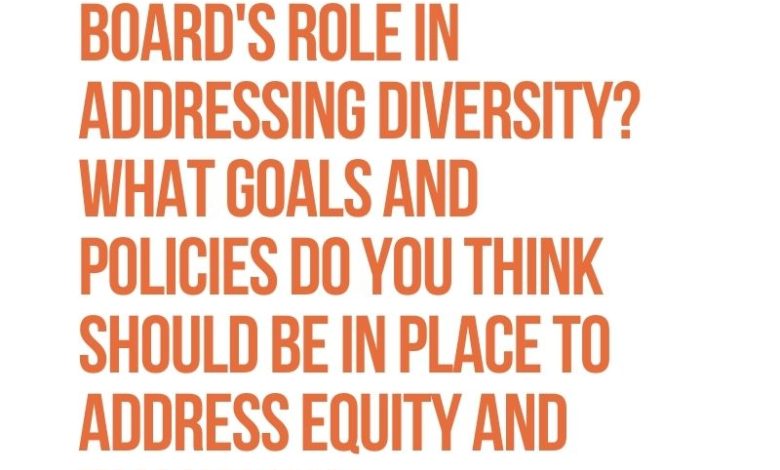What is the school board’s role in addressing diversity? What goals and policies do you think should be in place to address equity and inclusion?

In-Township (Vote for 2)
Rebecca Richardson: Diversity is a fancy word for differences. We have them; we always have had them. Eye color, hair color, presence or absence of freckles and birthmarks, hand dominance, height and weight are all examples of diversity. There was a time in our country when left-handed people were presumed witches are were drowned. We have grown to accept new norms in society that acknowledge that left-handed people may be a minority of the population, but they don’t represent evil merely by their presence. According to Mahomet’s ISBE report card, our community is getting more diverse not less. This is a fact, and we can choose to fear or ignore it, or we can plan for it to make sure we are serving the needs of all students who live here and go to school in our district. That is our obligation as a school district – to meet all students’ needs. There is a saying that one finger cannot lift a pebble. It is not one person’s job to address issues related to diversity. The school board’s role is to create policies that will keep all students in an equitable position when it comes to academics, the social learning community and to prepare students for being residents of a greater and even more diverse world beyond Mahomet. The work of the board needs to reside at the governance level to create accountability, continuity and commitment as well as clear messaging to the community.
Again, I believe that looking at this from a higher-level view helps to define the work that needs to be done. Every student who lives in this district has the right to an education that serves his or her needs. Striving to meet every student where they are must be the overarching policy because we are not only ethically responsible for educating all students, but we are also obligated to do so. We can either choose to ignore the changing demographics of our school system, or we can see those changes as an opportunity to rebrand ourselves moving forward. This process takes time – probably far more time than any of us will serve on the board of directors. However, the board’s role is and always will be to set policies and goals that enable the work to continue even when it isn’t comfortable, when it seems to stall, and when progress is slower than we feel it should be. Strong strategic focus in this area could greatly benefit the school district and its entire community.
Max McComb: Our role is to create a welcoming, inclusive learning environment that supports and respects all of our students. Our schools are diverse in many ways, and I have watched our demographics change quite a bit while I’ve been on the board. The board recently updated 3 policies that include statements about equity and diversity, and we continue our work with the University of Illinois consultants to address these issues. We are also investing in expanding professional development for our staff in these areas. Our students must develop the cultural competency skills that will support them in being successful in life after high school, where they will enter a world of diversity outside of the Mahomet-Seymour Schools.
Laura Lang: A role of the board is to keep a pulse on the currents within our community and anticipate upcoming cultural waves. Addressing diversity and inclusion should be as natural as addressing the school day schedule. While the national scene may complicate the issues, I believe we need to look at our local current situation to make our schools a safer, fairer environment for all learners. The board’s role is to kick start the process, encouraging the forming of committees to mull over and research the situation, and then make proposals for improvement.
I cannot address specific goals as I would rather that be a community process as previously stated; however, our students of all colors, shapes, sizes, religious backgrounds, families of origins, personal styles and dreams should feel at home in our schools. Students learn best in warm, welcoming environments with healthy structures. At the bare minimum, I would love for our educators to have the training they need to provide this environment. This means having access to a cultural consultation or professional who can advise them on challenging situations as they arise. Our teachers and building administrators are amazing educators, but may not have the cultural, social training to address these issues, thus it is the administrations responsibility to make sure they are equipped.
The school board and the superintendent have a wonderful opportunity to set the tone for the community as welcoming to all and celebrating our unique differences. Mahomet already has such marvelous examples of diversity, but as a new “buzzword” in our culture, it can often feel confusing or frustrating to know what that means. Quite simply, we need an openness to listen and understand different perspectives, and meet others where they are. I am hesitant to say what goals and policies need to be set as this is a conversation that the board as a whole should have. Together the board needs to set a district policy to then shape the diversity committees within each building. Without direction from the board, each committee would be acting, while well intentioned, without a cohesive guidance. While we already have a diversity statement for our district, this is an opportunity to explore what that mean practically and how we can work together to continue learning and supporting a thoughtful, self-examining environment for all.
Sunny McMurry: While our district has made significant strides in this area, we do have some work to do. When we are considering equity and inclusion, we need to move beyond just race and ethnicity. While race and ethnicity are obviously important, we also need to look at other marginalized populations here in Mahomet-Seymour. Within our district, we have diversity in family structure, home environment, socio-economic status and resource availability. We need to make sure we implement practices that honor these backgrounds and experiences, while using them as a way to create differentiated experiences for students. For instance, when looking at the achievement gap on IAR, there is a clear difference in achievement between students who have been identified as low-income learners compared to those who are considered non-low-income learners. This disparity indicates that we need to consider what children who come from low-income backgrounds need in comparison to non-low-income learners. For more details about these gaps, check out illinoisreportcard.com. So, an equitable school will do more of what our teachers have been doing– using students’ backgrounds and experiences to build differentiated instruction to support each child’s learning needs. Then, as an equitable district, we will be working to make sure all learners feel like they belong here.
Out-of-Township (Vote for 1)
Justin Lamb: Our students come from many different backgrounds and have different needs and learning styles. Being able to adjust the curriculum and teaching to specific needs is important. Working alongside the University of Illinois’s team is a great way to build a more inclusive and equitable environment where all students can see themselves in the curriculum.
Patrick MacKay: We need to acknowledge the fact our district’s demographics are changing. Five years ago, we were 96% white. Today we are 87% white. Mahomet is changing, just like the rest of the world around us. While inviting former students to speak about their experiences was a good start, it can’t be an isolated event. We need to find ways to continue that dialogue. As a start I encourage the school board to create a subcommittee, consisting of community members, to benchmark what other peer districts have done to encourage diversity. We can and should examine our existing process and practices for the presence of bias. Does our hiring process unconsciously prevent us from hiring minority candidates? Do they turn away minority candidates before they even apply? A more equitable and inclusive district includes a curriculum that reflects the colorful world around us. Are the textbooks we use still current, measured by publication date or the content itself? Can we introduce foreign language instruction earlier than we do today? Can we even introduce it in grade school? I would suggest we continue to liaise with experts from the University of Illinois, Illinois State, and Parkland. Finally, I believe this is also related to student readiness and the board’s obligation to ready our students for life after graduation when the majority will leave Mahomet for a world that is increasingly colorful and diverse.




